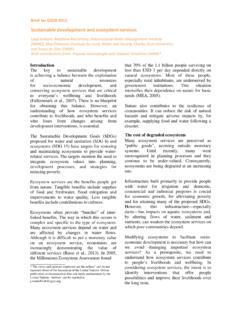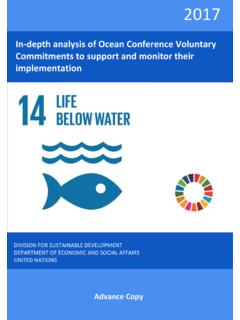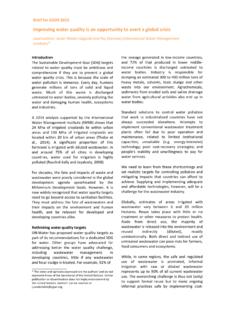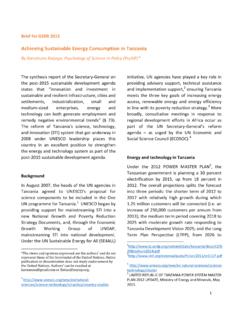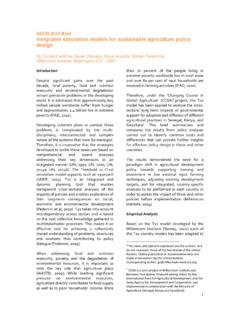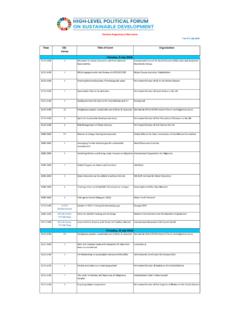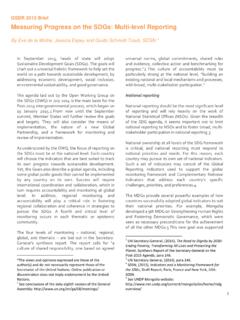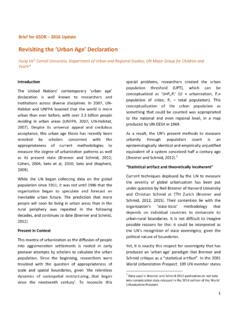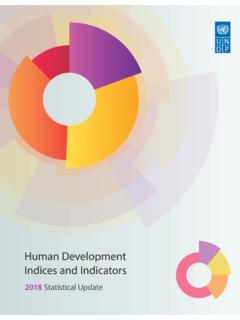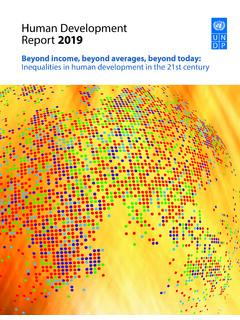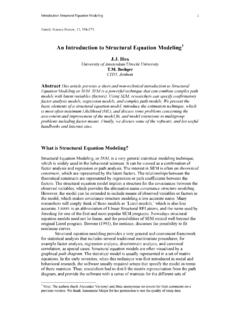Transcription of Integrating the three dimensions of sustainable development
1 The Post 2015 agenda promises a historical opportunity to shift from development in siloes to a more integrated approach; a view reinforced by the Rio+20 Outcome, MDG Summit Outcome, and the UN Secretary-General s report A life of dignity for all . The question is how?Considerable progress in human development has been achieved, but environmental degradation continues largely unabated, preventing the success of efforts to address poverty once and for all. Growth and prosperity are being achieved at the expense of the planet s life support systems, and at the expense of greater inequality. Disasters (both natural and man-made) are reversing development gains.
2 The three dimensions of sustainable development are clearly inter-dependent. Rio+20 committed Member States to develop a set of sustainable development goals (and targets and indicators) that would be balanced, coherent and comprehensive. three basic interlinkages underpin this cohesiveness and can be used as a filter to assess the completeness and robustness of the future goals, targets and indicators: UNEP Post 2015 Note #1 Integrating the three dimensions of sustainable developmentLeave no one behind and provide a life of dignity for all: The poor, vulnerable and marginalized groups in both developed and developing countries need opportunities for sustainable livelihoods and should be ensured of a minimum level of social and environmental protection and a basic standard of living.
3 The approximately billion people living in extreme poverty must be enabled to achieve a life of dignity. Those affected by extreme poverty and chronic unemployment, by lack of access to services (water, sanitation, energy, markets, health, education, shelter), by lack of rule of law, by discrimination, and unable to live in a clean and healthy environment, need to be at the centre of the future sustainable development agenda. Affordable solutions for breaking the poverty trap and assuring basic livelihoods are available that do not further degrade the environment. Innovative and green technologies can simultaneously increase employment, foster better use of science and traditional knowledge, upscale provision of basic services, and at the same time protect the environment.
4 Achieve greater prosperity in an inclusive manner within the capacity of the earth s life support system: The continued well-being of humanity, and the functioning of the economy and society, ultimately depends upon responsible management of the planet s finite natural resources, and protection of social and cultural heritage. Future prosperity will require that economic growth no longer degrades the environment. We need to change the production systems, employment patterns and technologies in every country, as well as accompanying behaviors that influence consumption and societal cohesion in other words, a universal transition towards an inclusive green economy and sustainable consumption and production.
5 In doing so, pervasive and deep rooted inequalities and discrimination should be addressed (including equitable access to natural resources). sustainable consumption is not necessarily about consuming less, it is about consuming better what we buy and how we live in an intelligent, safe and environmentally sustainable way. sustainable consumption can yield a variety of interlinked economic, social and health benefits, including greater access to markets, social innovation, job creation, reduced obesity, and civil society empowerment. Protection, improvement and wise use of the global life support system is needed in order not to cross ecological or social thresholds that would undermine or reverse development gains.
6 Countries are faced with different thresholds, but crossing the cumulative thresholds of the global commons, such as oceans and climate, will affect all countries whether developed or developing and ultimately the poorest will suffer as they are the most vulnerable, and lack the capacity to deal with the to achieve a balanced, ambitious and inclusive framework12 UNEP Post 2015 Note #1: Integrating the three dimensions of sustainable developmentIncrease capital for greater resilience and intergenerational equityLeave no onebehind A life of dignity for allEquity and prosperitywithin lifesupport systems Access to services Clean environment Decouple growth from environmental degradation Efficiency Durability Restoration Knowledge Comments and questions can be sent to: capital to achieve greater resilience and secure future generations livelihoods.
7 Investment in natural capital, social capital ( knowledge, societal systems), and resource efficient economic capital ( infrastructure and production capacities) will sustain long-term development and improve and increase the capacity of our planet from its present degraded state. This will enlarge our life support systems to achieve the simultaneous aspirations of leaving no one behind, achieving greater well-being and prosperity for all, while also securing our children s future. For example, waste management, resource efficiency, ecosystem restoration and cleaning of our water-ways expands our resources and opportunities for employment and livelihoods; investing in education and knowledge for sustainable development , including traditional and gender-based knowledge, expands our ability to innovate new solutions; and investing in more durable infrastructure increases resource efficiency but also secures services for future generations.
8 Achieving greater human resilience to social , economic, and environmental shocks will enhance our ability to adapt and manage effectively disruptive change. sustainable management of natural resources can be the engine for economic well-being as well as a platform for peace. 3 There are three other important considerations for formulating future SDGs, targets and indicators. They should build upon existing internationally agreed goals and targets, as agreed to in Rio+20. To do so, SDGs and the Post 2015 agenda should reinforce existing commitments. They would reinforce the urgency of implementation of commitments that are lagging. They would complement not duplicate commitments reached through other processes, including ongoing negotiations, such as on climate change.
9 They would set a vision for renewing commitments under agreements whose terms will expire in the coming decade, or highlight emerging issues. Solutions-oriented targets can best capture an integrated vision and at the same time be actionable. Such targets would support one or more goals. Indicators could be direct or proxy, and could be disaggregated to capture gender, equity and regional differentiation. A logical and coherent framework of goals, targets and indicators would facilitate implementation. The targets and indicators should be scientifically credible, verifiable, measurable, and based on best available information and evidence.
10 However, targets and indicators should also match the level of ambition: capacities should be built for new forms of measurement, such as integrated indices, that can become an incentive for inter-sectoral collaboration. When formulating SDGs and their targets and indicators, these six filters will help to recognize the importance of interlinkages, and effectively integrate the environmental, social and economic dimensions in a Post 2015 sustainable development Agenda. sustainable development is not possible by addressing the risks and challenges of any dimension in a singular fashion.
